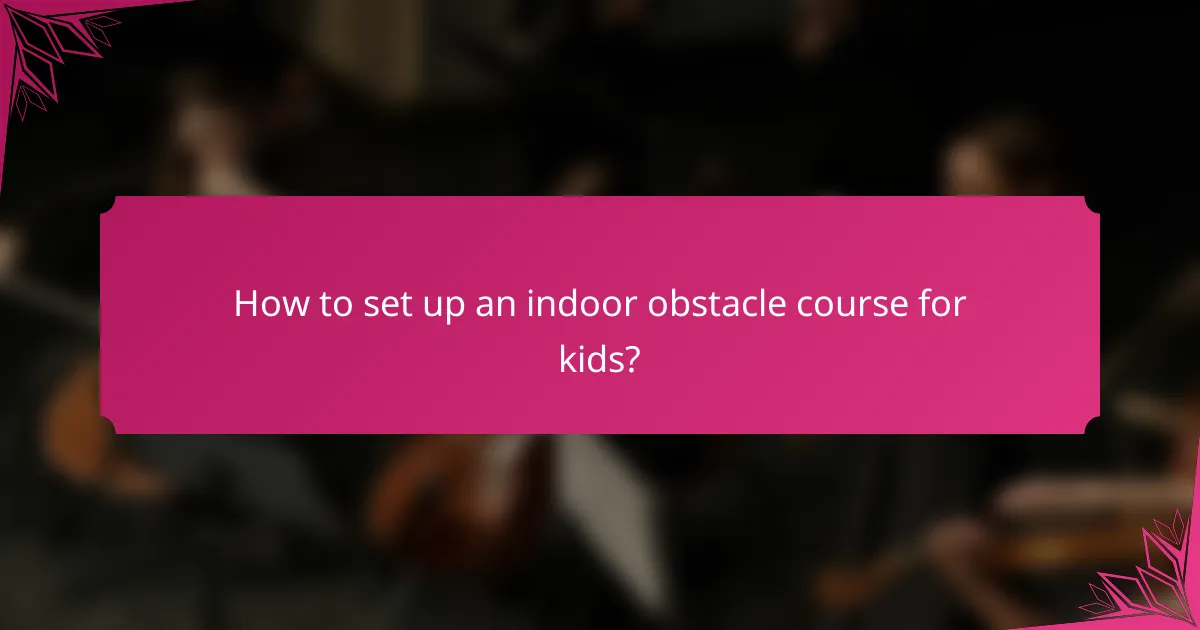Creating an indoor obstacle course for kids can be an exciting way to keep them active and entertained, all while using everyday household items. To ensure a fun and safe experience, it’s essential to plan the setup carefully, prioritize supervision, and regularly check for hazards. With a little creativity, you can design a variety of challenges that cater to different skill levels and interests, making playtime both engaging and safe.

How to set up an indoor obstacle course for kids?
Setting up an indoor obstacle course for kids involves creating a fun and safe environment where they can navigate various challenges. This can be done using common household items and requires careful planning to ensure safety and engagement.
Materials needed for setup
To create an indoor obstacle course, gather materials that are safe and easy to manipulate. Common items include cushions, chairs, hula hoops, blankets, and cones. You may also want to use tape to mark boundaries and create paths.
Ensure that all materials are sturdy and can withstand the activity level of children. Avoid sharp objects or anything that could easily tip over and cause injury.
Step-by-step setup instructions
Begin by selecting a spacious area free from breakables. Start by laying out your course design on paper, incorporating various challenges such as crawling under tables, jumping over cushions, and balancing on a line of tape.
Once you have a plan, arrange the materials according to your design. Secure any loose items and ensure that pathways are clear. Finally, test the course yourself to confirm that it is safe and fun before letting the kids try it out.
Recommended layouts for different spaces
For smaller spaces, consider a linear layout where kids move from one challenge to the next in a straight line. Use furniture to create barriers and obstacles that fit within the room’s dimensions.
In larger areas, you can create a more complex course with multiple paths and challenges. Incorporate elements like a zigzag pattern or a circular route to keep kids engaged and moving. Always adjust the difficulty based on the age and skill level of the children participating.

What safety tips should be followed?
To ensure a safe indoor obstacle course for kids, prioritize supervision, proper setup, and the use of safety gear. Regularly inspect the course for hazards and maintain a clear area for play to prevent accidents.
Essential safety gear for kids
When setting up an indoor obstacle course, equip children with essential safety gear to minimize injuries. Items like helmets, knee pads, and elbow pads can provide crucial protection during physical activities.
Consider using non-slip socks or shoes to enhance grip and stability while navigating the course. Additionally, soft mats or padding can be placed under obstacles to cushion falls and provide a safer landing area.
Common hazards to avoid
Be aware of common hazards that can arise during indoor obstacle courses. Sharp edges on furniture or equipment should be covered or removed to prevent cuts and scrapes. Ensure that the course is free of tripping hazards, such as loose cables or clutter.
Also, avoid using heavy or unstable objects as obstacles, as they can topple over and cause injuries. Regularly check the setup to ensure that all components are secure and that the play area remains clear and safe for children.

What are the best indoor obstacle course ideas?
The best indoor obstacle course ideas combine creativity and safety to engage kids in fun physical activity. Using common household items, you can create a variety of challenges that cater to different skill levels and interests.
Creative themes for obstacle courses
Incorporating themes can make an indoor obstacle course more exciting. Popular themes include jungle adventures, space missions, and pirate treasure hunts. Each theme can inspire specific challenges, such as crawling under “vines” made from blankets or jumping over “lava” using pillows.
To enhance the experience, consider using props that match the theme. For example, for a jungle theme, you could use stuffed animals as obstacles or create a “river” using blue fabric. This not only adds visual appeal but also encourages imaginative play.
Age-appropriate challenges
When designing an obstacle course, it’s crucial to tailor challenges to the age and ability of the children participating. Younger kids might enjoy simple tasks like crawling through tunnels or balancing on a line of tape, while older children can handle more complex activities like jumping over hurdles or climbing over furniture.
Ensure that each challenge is safe and achievable. For instance, set a maximum height for climbing obstacles to prevent falls, and provide clear instructions to avoid confusion. Regularly assess the course as kids play to make adjustments based on their skill levels and safety needs.

How to engage kids during the activity?
Engaging kids during an indoor obstacle course activity involves creating a fun and interactive environment that encourages participation. Use creative challenges and games to maintain their interest and excitement throughout the course.
Fun games to incorporate
Incorporating games into the obstacle course can enhance the overall experience. Consider adding relay races, where kids must complete sections of the course in teams, or timed challenges to see who can finish the course the fastest. These elements introduce a competitive spirit that can motivate kids to give their best effort.
Another fun game is the “follow the leader” format, where one child demonstrates how to navigate the obstacles, and others mimic their movements. This not only fosters teamwork but also allows kids to learn from each other.
How to motivate kids to participate
Motivating kids to participate in the obstacle course can be achieved through positive reinforcement and rewards. Offer small prizes for completing the course or for showing good sportsmanship. Acknowledging their effort with cheers or high-fives can also boost their enthusiasm.
Additionally, setting achievable goals, such as completing the course within a certain time or mastering a specific obstacle, can encourage kids to push themselves. Make sure to celebrate their accomplishments, no matter how small, to keep their spirits high and encourage ongoing participation.

What are the benefits of indoor obstacle courses?
Indoor obstacle courses provide numerous benefits for children, including physical fitness and cognitive development. These engaging setups encourage kids to be active while improving their problem-solving skills and coordination.
Physical health benefits
Indoor obstacle courses promote physical health by enhancing strength, flexibility, and cardiovascular fitness. Activities like climbing, jumping, and crawling engage multiple muscle groups, helping children develop overall fitness.
To maximize these benefits, ensure the course includes a variety of movements. For example, incorporate balance beams, tunnels, and hurdles to challenge different physical skills. Regular participation can lead to improved endurance and a healthier lifestyle.
Cognitive development advantages
Engaging in obstacle courses also supports cognitive development by fostering critical thinking and decision-making skills. As children navigate through challenges, they learn to assess risks, strategize, and adapt their approach.
For instance, setting up a course that requires kids to choose between different paths can enhance their problem-solving abilities. Encourage them to think creatively about how to overcome obstacles, which can boost their confidence and mental agility.

How to choose the right equipment?
Selecting the right equipment for an indoor obstacle course involves considering safety, age appropriateness, and the available space. Look for items that are durable, easy to set up, and can be adjusted to suit different skill levels.
Top brands for obstacle course equipment
Some of the leading brands for indoor obstacle course equipment include Ninja Warrior, Skywalker Trampolines, and Gonge. These brands are known for their quality and safety features, offering a range of products from climbing walls to balance beams.
When choosing a brand, consider customer reviews and safety certifications. Equipment that meets ASTM or EN standards is generally a safer choice for kids.
Budget-friendly options
If you’re looking for budget-friendly options, consider DIY solutions or brands like Little Tikes and Step2, which offer affordable yet sturdy equipment. You can also find second-hand items at local marketplaces or online platforms.
For a cost-effective setup, focus on versatile items like foam blocks, tunnels, and cones that can be rearranged to create different challenges. This approach allows for creativity without breaking the bank.

What are the emerging trends in kids’ activities?
Emerging trends in kids’ activities focus on engaging, interactive, and educational experiences that promote physical and mental development. Indoor obstacle courses are gaining popularity as they combine fun with fitness, allowing children to explore their creativity while staying active.
Indoor Obstacle Course Setup
Setting up an indoor obstacle course involves using everyday household items to create challenges that encourage movement and coordination. Common materials include cushions, chairs, hula hoops, and blankets. Arrange these items to form a path that kids can navigate through, jumping, crawling, and balancing along the way.
Consider the space available and the age of the children participating. For younger kids, keep obstacles low and simple, while older children may enjoy more complex challenges. Ensure there is enough room for safe movement and that the course can be easily adjusted as kids grow or improve their skills.
Safety Tips
Safety is paramount when creating an indoor obstacle course. Start by ensuring the area is clear of sharp objects and that the floor is free from tripping hazards. Use soft materials like mats or pillows to cushion falls, and supervise children closely as they navigate the course.
Establish clear rules for the obstacle course, such as one child at a time and no pushing or shoving. Regularly check the setup for stability and make adjustments as needed to prevent accidents. Encourage kids to wear appropriate footwear to enhance grip and reduce the risk of slipping.
